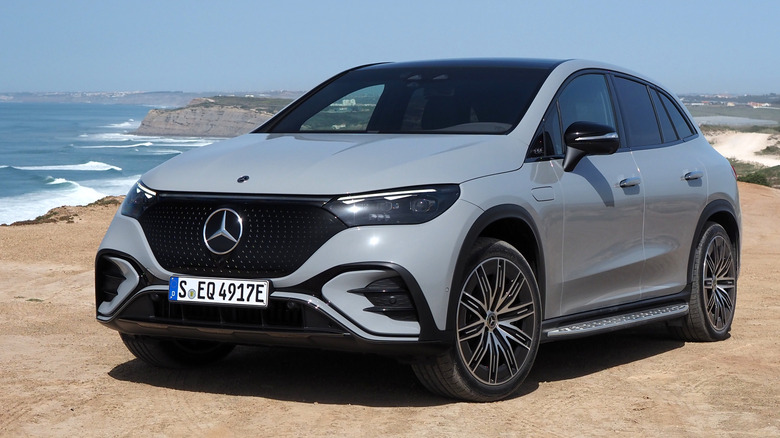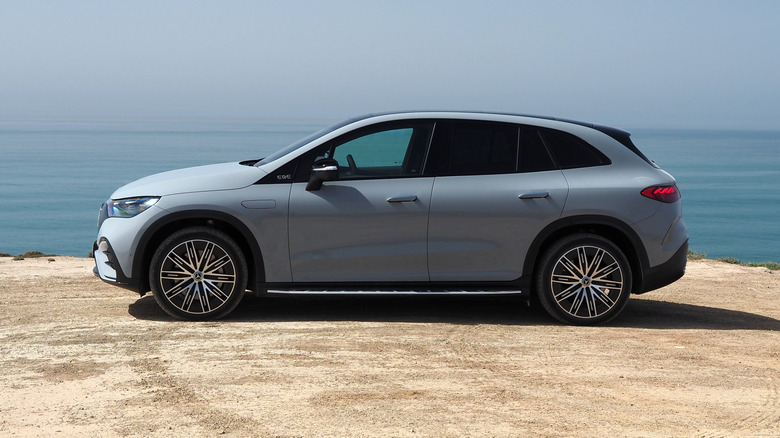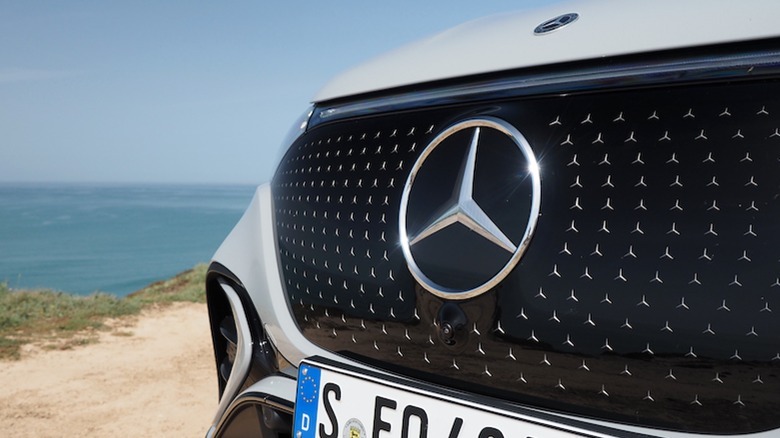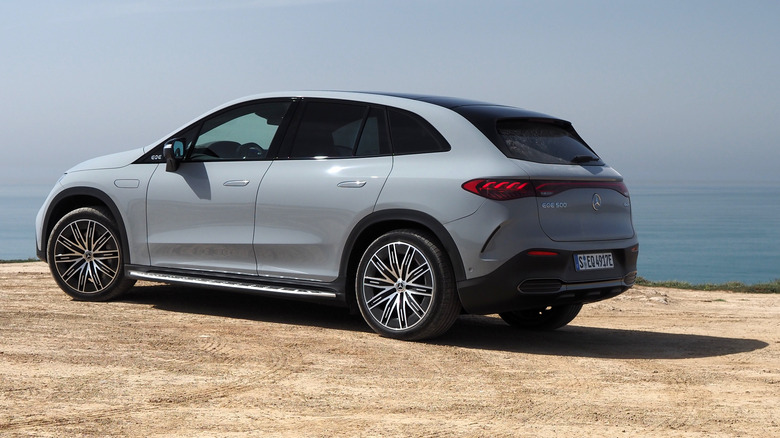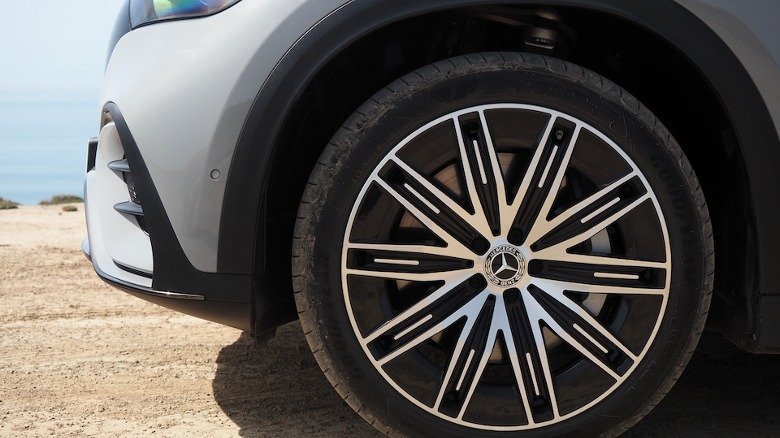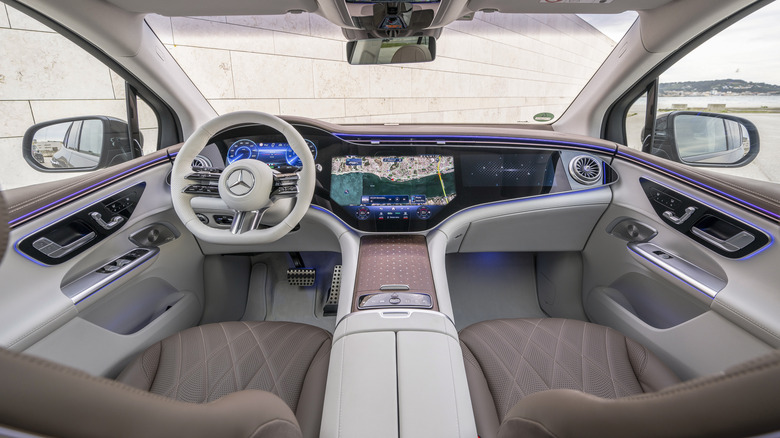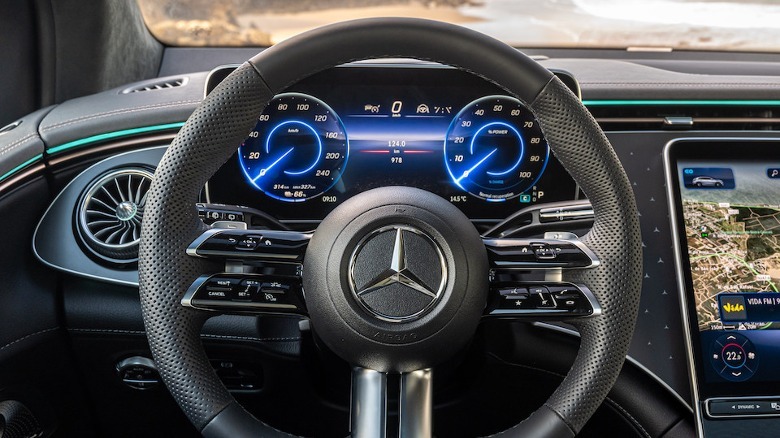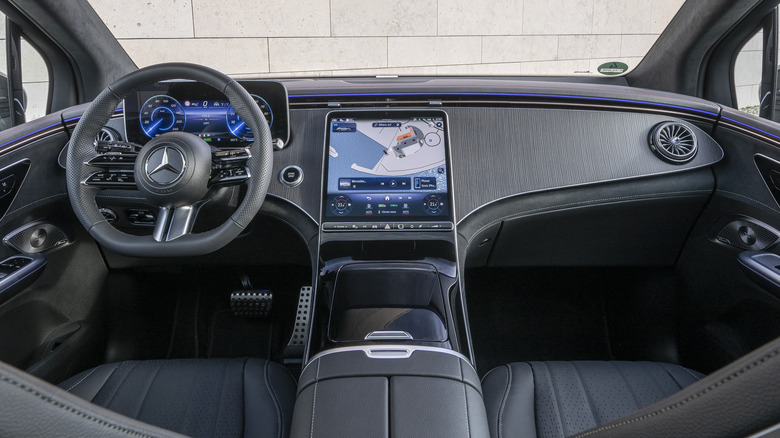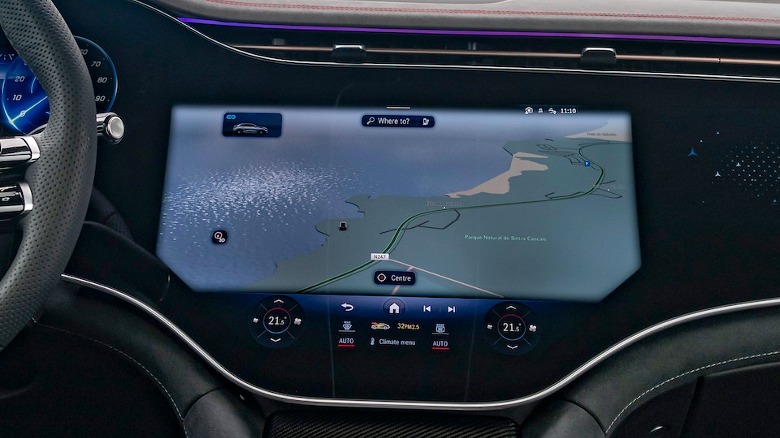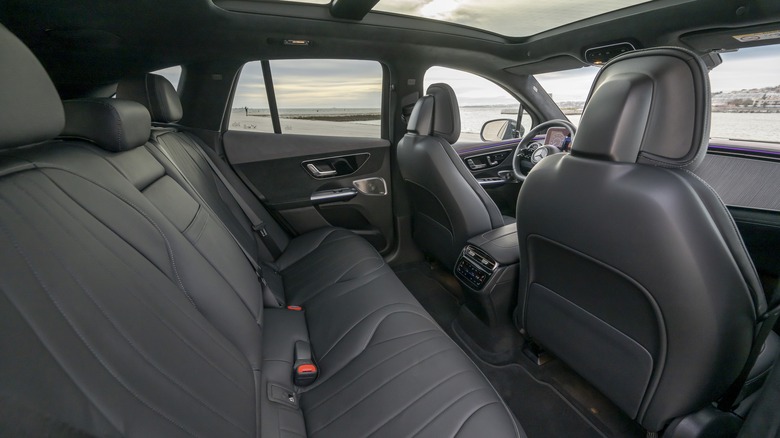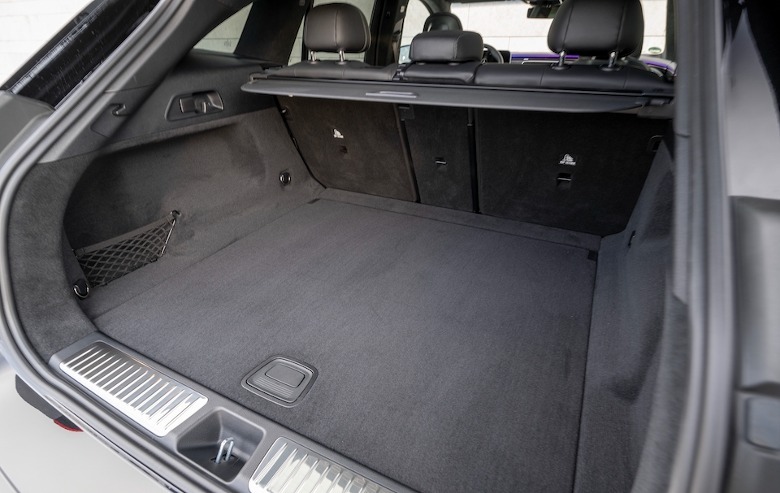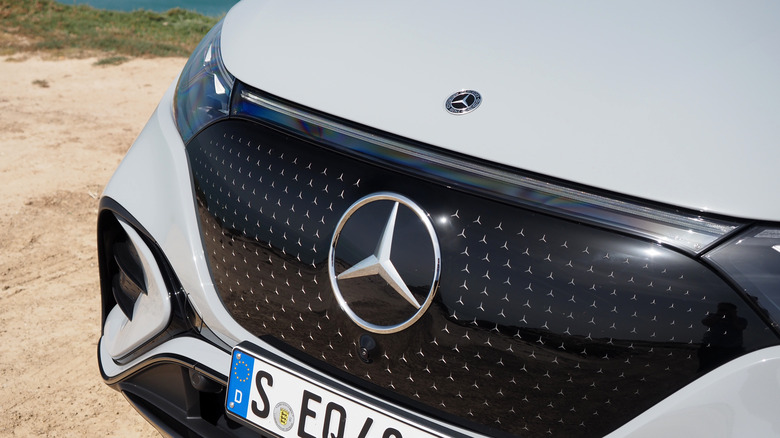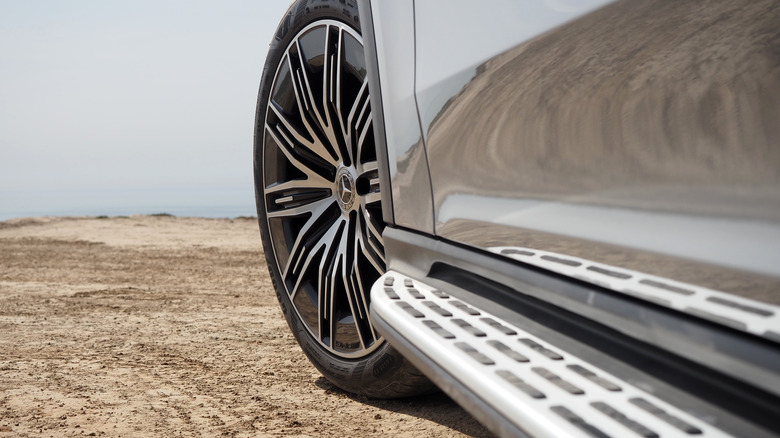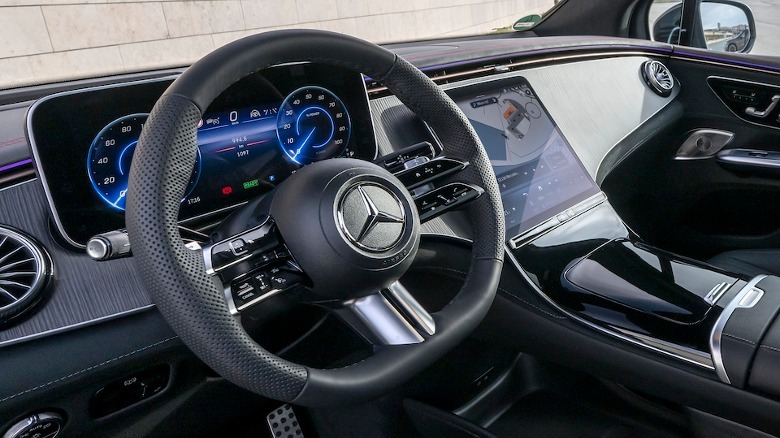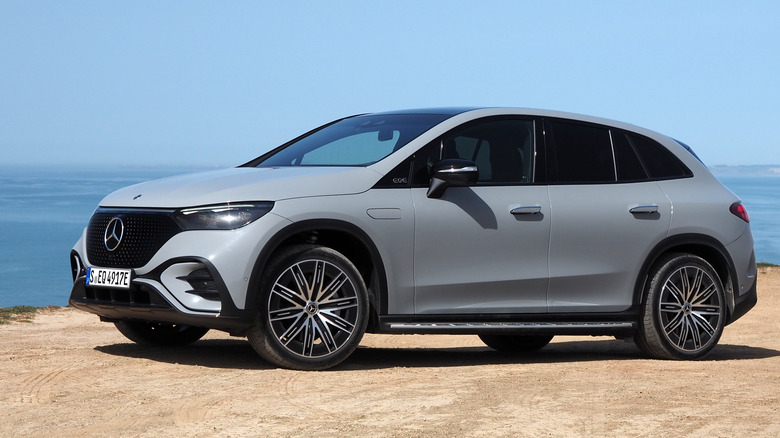2023 Mercedes-Benz EQE SUV First Drive: Because The Electric Recipe Works
Mercedes is arguably the king at filling in the gaps. Few automakers embraced the ethos of "a variant for every driver" quite so aggressively: if a regular sedan doesn't fit your lifestyle, or an SUV, then you can have a swoopy coupe version of a crossover, or a four-door sports car, or any of the other niches within niches that have seen the Mercedes range flourish.
Now, it's the turn of Mercedes' EQ series to replicate like bunnies. From an outlier in the lineup to a rising tide of zero-emissions options, electric vehicles are steadily becoming the new normal. Just as the EQS luxury sedan spawned its EQS SUV variant, now the EQE sedan is doing the same with the 2023 Mercedes-Benz EQE SUV.
As recipes go, it's hardly a complicated one. Take a now-familiar electric architecture, add extra ride height and a more flexible body, and load up on the tech and creature comforts modern Mercedes buyers have come to expect. Recipes, though, aren't always foolproof, so is the new EQE SUV a prime rib or a deflated soufflé?
Chunky and charming
Certainly, at first glance, the newest all-electric model on Mercedes' forecourt looks as sleek as a perfectly baked cake. Aerodynamics rules the roost in the EV world, but the EQ series has taken that to heart more than most. Hunting lower coefficient of drag numbers has led to a super-smooth profile, and if the EQE SUV sheds a little of its sedan cousins' slinkiness in return for a more practical and capacious body, the result still feels leagues away from "traditional" trucks nonetheless.
In fact, there's a hint of the hatchback about it, though I doubt anybody at Mercedes would necessarily appreciate the suggestion. At the front, the narrow headlamps and outsized black fascia are joined by a light bar spanning the leading edge of the hood. The rear is similarly joined-up, a crescent of crisp red linking the lamp clusters.
It's from the side where things get interesting. Though it shares the same EVA platform as the EQE sedan, Mercedes trimmed around 3.5 inches from the wheelbase. Add in a little extra height, and either 19- or 20-inch wheels (depending on drivetrain and trim), and you get a chunky, charming crossover that looks smaller than it actually is.
Three models to choose between
For the U.S., there'll be three variants. The entry 2023 EQE 350+ SUV will start at $77,900 (plus $1,150 destination), and have a single, 215 kW electric motor driving the rear axle. It'll be rated for 279 miles of EPA range — the most for any EQE SUV variant at launch — and offer 288 horsepower and 417 lb-ft of torque. Zero to 60 mph will arrive in 6.3 seconds, with Mercedes quoting a 130 mph top speed.
Trading a little range for traction, the 2023 EQE 350 4MATIC will be priced from an identical $77,900. It adds a front electric motor, but range — with all-season tires — from the 90.6 kWh battery dips to an EPA-rated 253 miles. However, you get 564 lb-ft of torque instead, and the zero to 60 mph time is trimmed ever so slightly to 6.2 seconds.
The 2023 EQE 500 4MATIC is — until the AMG variant lands — the flagship of the series. Priced from $89,500 (plus destination), it has 402 horsepower and 633 lb-ft of torque from its twin electric motors, slashing the zero to 60 dash to 4.6 seconds.
Comfort suspension is standard, but Mercedes offers Airmatic air suspension as an option. That can increase ground clearance by an inch, as well as drop the body of the SUV by up to 0.8 inches at speed, to bolster aerodynamics. As we've seen on the EQS SUV, meanwhile, rear-wheel steering can also be added.
A familiar cabin is no bad thing
Tug on the pop-out door handle, and that same sense of familiarity carries over to the interior. That's no bad thing, as Mercedes' cabin aesthetic has been a solid one, though your experience — and the tech you'll have to play with — will depend considerably on which drivetrain and trim you cough up for.
All trims get a potent Burmester 3D sound system with Dolby Atmos, 64-color ambient lighting, wireless smartphone projection and a wireless charger, and a fingerprint sensor for loading the driver profile. A panoramic sunroof, keyless start, and Mercedes' MBUX infotainment system with navigation are also standard.
Normally, MBUX runs on a 12.8-inch portrait-aspect OLED touchscreen in the center console; the driver also gets a 12.3-inch digital cluster display. Mercedes' Hyperscreen is optional, enlarging the center touchscreen and adding a third for the front seat passenger, all sandwiched in a single swathe of glass. Attention-monitoring cameras mean that, while the passenger can watch movies or other video content, their display is deactivated should the driver try to sneak a look.
Skip the Hyperscreen
Even as display-saturated cabins proliferate, Hyperscreen still impresses. Personally, though, I'd go for Mercedes' standard dashboard. Its infotainment is no less feature-rich, but the expanse of wood looks a lot classier, to my eyes, ahead of the front passenger. All that Hyperscreen piano black glass is a dust and fingerprint magnet, too.
Either way, it's a comprehensive hub from which to access the EQE SUV's features. Mercedes floats widgets atop the default map view for things like multimedia, quickly hunting down charging stations, and jumping into smartphone projection. Other settings, though, do require some menu digging, which is where it can get a little complex.
Dedicated controls for switching drive modes — all EQE SUVs get Comfort, Sport, Eco, and Individual; 4MATIC models get Off-Road, too — along with volume and other shortcuts are welcome, while the HVAC controls are persistent along the bottom of the infotainment UI. You can control them by voice, too; MBUX's "Hey Mercedes" trigger is capable of tweaking temperature, locating points of interest, or even switching massage settings on cars with the optional Multicontour front seats.
Filling up
In the U.S., Mercedes' Comfort seats will be standard — the automaker knows its American customers enjoy their creature comforts, like standard heating and optional ventilation — and the EQE SUV's cabin is generally spacious. First and second-row accommodations are plenty big enough for four adults, despite the trim in wheelbase compared to the EQE sedan.
The trunk, though, feels oddly small: 14 cubic feet with both rows of seats up, expanding to 55 cu-ft with the second row folded flat. Unsurprisingly, that's less than in an EQS SUV — which also offers a (snug) third-row option, which the EQE SUV lacks — but it's also considerably down compared to the similarly-scaled BMW iX. 4MATIC versions of the EQE SUV are rated to tow up to 3,500 pounds.
As for charging, both single- and dual-motor models top out at 170 kW DC fast charging. That means a 32-minute charge on a suitably-potent connection is enough to get you from 10% to 80%, Mercedes claims. On the typical Level 2 home charger, figure on 9.5 hours to go from 10% to 100%.
Part of the challenge, here, is that Mercedes is still using 400-volt architecture, whereas rivals have already shifted to 800-volt. The automaker's argument is that higher voltage isn't a target, so much as an enabler, and points to its work there to improve the overall charging experience. EQE SUV buyers will get two years of unlimited 30-minute Electrify America sessions, but the real game-changer will be Mercedes' own charging network that's expected to begin operations sometime later in 2023.
Plenty of assistance
While we'll need to wait for dedicated Mercedes chargers, the EQE SUV has plenty to recommend it now. A heat pump is standard, for example, capable of coaxing out greater efficiency even in the sort of cold weather conditions that EV drivers have traditionally feared. Blind-spot assistance, active lane-keeping assist, parking assist, a 360-degree camera, and active brake assist are all standard, too.
Options include the Driving Assistant Package, with active steering assistance, lane change assistance, evasive steering assist, and Active Distance Assist DISTRONIC. The latter is Mercedes' hands-on adaptive cruise control, which automatically adjusts speed depending on the road topography. Sadly, the Drive Pilot hands-off Level 3 system isn't available on the EQE SUV, though considering — at the time of writing — just one U.S. state actually allows it to operate, that's not an omission worth getting too frustrated by today.
On the road
With a familiar platform to play with, you'll be unsurprised to hear that the EQE SUV drives much like its EQ siblings. Neither of the 350 variants — rear-wheel drive or all-wheel drive — are going to melt your face off with their acceleration, but they're perky and nimble, and the power levels feel "just right" for everyday driving. Step up to the EQE 500 4MATIC SUV, and the extra grunt is noticeable, though still not overwhelming. There's clearly plenty of headroom left for the upcoming AMG EQE SUV, which will tote up to 677 horsepower.
Having tried both the standard Comfort suspension and the optional Airmatic air suspension, I find myself leaning toward the former. Certainly, Mercedes' air springs provide plush cushioning in Comfort mode, but the EQE SUV's ride generally feels a little more involved than you might expect. Even in Sport mode, it doesn't particularly encourage enthusiastic driving — an EQE sedan, with both curb weight and center of gravity lower, is more rewarding there — and undulating roads or shoddy asphalt can prove unsettling.
Mercedes offers three levels of regenerative braking, controlled using the steering wheel paddles. At its strongest, the EQE SUV will slow aggressively when you lift off the accelerator; at its mildest, it'll coast smoothly, ideal for highway jaunts.
An option worth paying for is rear-axle steering, which can tilt the rear wheels by up to 10 degrees. At low speeds, that effectively cuts the wheelbase for a tighter turning circle: 34.5 feet, versus the 40.4 feet of the regular axle. At higher speeds, meanwhile, you get greater stability during things like highway lane changes. It definitely leaves the EQE SUV feeling more maneuverable.
2023 Mercedes-Benz EQE SUV Verdict
Pleasant as the EQE 500 4MATIC SUV's extra torque is, it's hard to argue that the sweet spot in the line-up is around a more conservatively-spec'd EQE 350. Those in fair weather states should probably go for the EQE 350+ SUV for its extra range; anybody facing snow and ice will probably want the EQE 350 4MATIC SUV for its bump in traction. Either way, solid levels of standard specification mean eschewing Mercedes' options list isn't quite as difficult as it can be.
Elsewhere, BMW's iX provides a more spirited driving experience and a more divisive aesthetic. It also demands more from your wallet to get behind the wheel, starting at $87,100 (plus destination). An Audi Q8 e-tron is similarly expensive, though its sizable standard battery in the U.S. should make it longer-legged than the Mercedes. Or, you could sacrifice badge prestige and the fancy cabin, and go for a cheaper Tesla Model Y, though I'm not entirely sure the EQE SUV's audience would cross-shop there.
What stands out is how gimmick-free the 2023 Mercedes-Benz EQE SUV feels. We're beyond a time when automakers might have a single EV option in their range that grudgingly concedes electrification is the future. Instead, the EQE SUV feels like, well, a Mercedes SUV that happens to be electric: you can imagine it slotting seamlessly into daily life, with minimal fuss. That may not be as exciting as an oddly-shaped outlier amid the gas-guzzlers, but an EV for every category has the potential to move the needle on zero-emissions far more effectively.
